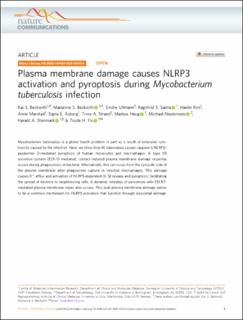| dc.contributor.author | Beckwith, Kai Sandvold | |
| dc.contributor.author | Beckwith, Marianne Sandvold | |
| dc.contributor.author | Ullmann, Sindre | |
| dc.contributor.author | Sætra, Ragnhild Sofie Ragnhildstveit | |
| dc.contributor.author | Kim, Haelin | |
| dc.contributor.author | Marstad, Anne | |
| dc.contributor.author | Åsberg, Signe Elisabeth | |
| dc.contributor.author | Strand, Trine Aakvik | |
| dc.contributor.author | Haug, Markus | |
| dc.contributor.author | Niederweis, Michael | |
| dc.contributor.author | Stenmark, Harald Alfred | |
| dc.contributor.author | Flo, Trude Helen | |
| dc.date.accessioned | 2020-11-04T10:11:30Z | |
| dc.date.available | 2020-11-04T10:11:30Z | |
| dc.date.created | 2020-09-25T16:44:47Z | |
| dc.date.issued | 2020 | |
| dc.identifier.issn | 2041-1723 | |
| dc.identifier.uri | https://hdl.handle.net/11250/2686324 | |
| dc.description.abstract | Mycobacterium tuberculosis is a global health problem in part as a result of extensive cytotoxicity caused by the infection. Here, we show how M. tuberculosis causes caspase-1/NLRP3/gasdermin D-mediated pyroptosis of human monocytes and macrophages. A type VII secretion system (ESX-1) mediated, contact-induced plasma membrane damage response occurs during phagocytosis of bacteria. Alternatively, this can occur from the cytosolic side of the plasma membrane after phagosomal rupture in infected macrophages. This damage causes K+ efflux and activation of NLRP3-dependent IL-1β release and pyroptosis, facilitating the spread of bacteria to neighbouring cells. A dynamic interplay of pyroptosis with ESCRT-mediated plasma membrane repair also occurs. This dual plasma membrane damage seems to be a common mechanism for NLRP3 activators that function through lysosomal damage. | en_US |
| dc.language.iso | eng | en_US |
| dc.publisher | Nature Research | en_US |
| dc.relation.uri | https://www.nature.com/articles/s41467-020-16143-6 | |
| dc.rights | Navngivelse 4.0 Internasjonal | * |
| dc.rights.uri | http://creativecommons.org/licenses/by/4.0/deed.no | * |
| dc.title | Plasma membrane damage causes NLRP3 activation and pyroptosis during Mycobacterium tuberculosis infection | en_US |
| dc.type | Peer reviewed | en_US |
| dc.type | Journal article | en_US |
| dc.description.version | publishedVersion | en_US |
| dc.source.volume | 11 | en_US |
| dc.source.journal | Nature Communications | en_US |
| dc.identifier.doi | https://doi.org/10.1038/s41467-020-16143-6 | |
| dc.identifier.cristin | 1833639 | |
| dc.relation.project | Norges forskningsråd: 245963 | en_US |
| dc.relation.project | Norges forskningsråd: 287696 | en_US |
| dc.relation.project | Norges forskningsråd: 223255 | en_US |
| dc.description.localcode | Open Access This article is licensed under a Creative Commons Attribution 4.0 International License, which permits use, sharing, adaptation, distribution and reproduction in any medium or format, as long as you give appropriate credit to the original author(s) and the source, provide a link to the Creative Commons license, and indicate if changes were made. The images or other third party material in this article are included in the article’s Creative Commons license, unless indicated otherwise in a credit line to the material. If material is not included in the article’s Creative Commons license and your intended use is not permitted by statutory regulation or exceeds the permitted use, you will need to obtain permission directly from the copyright holder. To view a copy of this license, visit http://creativecommons.org/licenses/by/4.0/. | en_US |
| cristin.ispublished | true | |
| cristin.fulltext | original | |
| cristin.qualitycode | 2 | |

